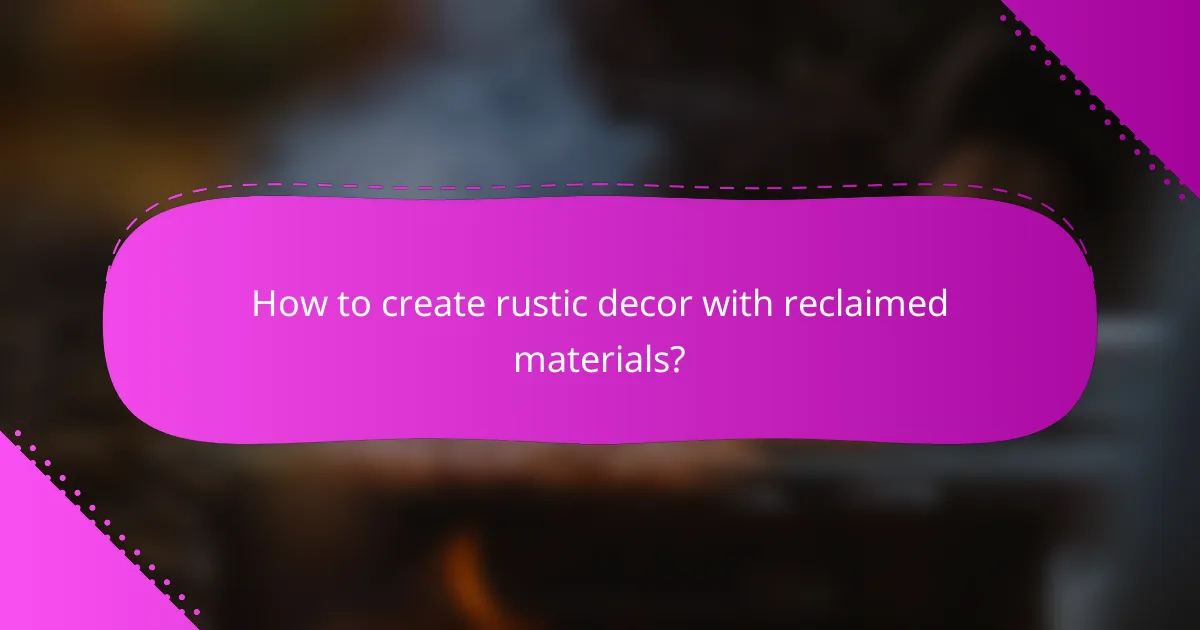Transforming your home with rustic decor using reclaimed materials is a creative and sustainable choice. By engaging in cost-effective DIY projects, you can craft unique accents that reflect your personal style while repurposing items that might otherwise be discarded. Explore various sources for reclaimed materials to discover endless possibilities for adding warmth and character to your space.

How to create rustic decor with reclaimed materials?
Creating rustic decor with reclaimed materials involves using salvaged items to add character and warmth to your space. This approach not only promotes sustainability but also allows for unique, cost-effective design elements that reflect personal style.
Use reclaimed wood for furniture
Reclaimed wood is a popular choice for rustic furniture due to its durability and unique grain patterns. Consider sourcing wood from old barns, pallets, or furniture pieces that can be disassembled. This wood can be transformed into tables, chairs, or shelving units, adding a distinctive touch to your home.
When working with reclaimed wood, inspect it for nails or damage. Sanding and sealing the wood can enhance its appearance while preserving its rustic charm. Aim for a finish that complements your overall decor style, whether that’s a natural look or a more polished finish.
Incorporate vintage metal accents
Vintage metal accents can enhance the rustic aesthetic by introducing texture and contrast. Look for items like old tools, metal buckets, or vintage signage that can be repurposed as decor. These pieces can serve as wall art, centerpieces, or functional items like coat hooks.
When selecting metal accents, consider the color and patina. Rusty or weathered finishes often work best in rustic settings. Mixing different metals, such as iron and brass, can create visual interest, but keep the overall look cohesive by sticking to a similar color palette.
Repurpose old doors as decor
Old doors can be creatively repurposed to add a rustic focal point to any room. They can serve as headboards, wall art, or even as a unique table. Look for doors with interesting hardware or unique designs to enhance their visual appeal.
Before using an old door, ensure it is structurally sound. Clean and refinish it as needed to fit your decor style. If using it as a table, consider adding sturdy legs or a base to ensure stability. This project can be a great conversation starter while showcasing your commitment to sustainable design.

What are cost-effective DIY rustic decor projects?
Cost-effective DIY rustic decor projects utilize reclaimed materials to create charming and unique home accents. These projects not only save money but also contribute to sustainability by repurposing items that might otherwise go to waste.
Make pallet wood shelves
Pallet wood shelves are a popular choice for rustic decor due to their availability and affordability. You can often find used pallets for free or at a low cost, making them an excellent material for shelving projects.
To create pallet wood shelves, start by disassembling the pallets and sanding the wood to remove any rough edges. Assemble the pieces into your desired shelf shape, securing them with screws or brackets. Consider adding a coat of stain or sealant to enhance the wood’s natural beauty and protect it from wear.
Create mason jar centerpieces
Mason jar centerpieces are versatile and easy to customize, making them perfect for rustic decor. They can be filled with flowers, candles, or seasonal items, allowing for a fresh look with minimal cost.
To make these centerpieces, gather mason jars and fill them with your chosen items. You can wrap the jars with twine or burlap for added texture. These centerpieces work well for events or as everyday decor, and they can be easily adapted to fit different themes or seasons.
Build a farmhouse table
A farmhouse table is a centerpiece of rustic decor, providing a warm and inviting atmosphere. Building one can be a rewarding project that adds character to your dining space without breaking the bank.
For a basic farmhouse table, use reclaimed wood for the tabletop and sturdy lumber for the legs. The construction involves cutting the wood to size, assembling the frame, and attaching the tabletop. Consider using a simple design to keep costs low, and finish with a protective stain or paint to enhance durability.

Where to find reclaimed materials in the UK?
Reclaimed materials can be sourced from various places across the UK, offering unique options for rustic decor projects. Key locations include local salvage yards, online marketplaces, and community recycling centers, each providing distinct advantages for DIY enthusiasts.
Local salvage yards
Local salvage yards are treasure troves for reclaimed materials, often housing a wide variety of items like wood, bricks, and fixtures. Visiting these yards allows you to inspect materials firsthand, ensuring quality and suitability for your projects.
When searching for salvage yards, consider calling ahead to check their inventory or visiting during sales events for better deals. Prices can vary significantly, so it’s wise to compare costs between different yards.
Online marketplaces like eBay
Online marketplaces such as eBay provide a convenient way to find reclaimed materials from the comfort of your home. You can browse listings for specific items, often at competitive prices, and even negotiate with sellers.
Be sure to check seller ratings and reviews to ensure reliability. Shipping costs may apply, so factor that into your budget when purchasing larger items. Look for local sellers to minimize delivery fees.
Community recycling centers
Community recycling centers often have sections dedicated to reclaimed materials, including furniture and building supplies. These centers may offer items at low prices or even for free, making them a cost-effective option for DIY projects.
Check with your local council for information on recycling centers in your area and their specific offerings. Some centers may have regular events or sales, so staying informed can lead to great finds.

What are the benefits of using reclaimed materials?
Using reclaimed materials offers numerous advantages, including environmental sustainability, unique aesthetic appeal, and potential cost savings. These benefits make reclaimed materials a popular choice for rustic decor projects.
Eco-friendly and sustainable
Reclaimed materials significantly reduce waste by repurposing wood, metal, and other resources that would otherwise end up in landfills. This practice conserves natural resources and minimizes the carbon footprint associated with new material production.
Choosing reclaimed items also supports sustainable practices in the building and design industries. By opting for these materials, you contribute to a circular economy that prioritizes reuse and recycling.
Unique character and history
Reclaimed materials often come with a rich history and unique character that new materials lack. Each piece tells a story, whether it’s barn wood from a century-old structure or metal salvaged from an industrial site.
This distinctiveness allows for personalized decor that reflects individual style. Incorporating these materials can create focal points in your home, making your space feel more inviting and authentic.
Cost savings on materials
Using reclaimed materials can lead to significant cost savings compared to purchasing new items. Prices for reclaimed wood or metal can vary widely, but they often fall within a lower range than new, high-quality materials.
Additionally, many reclaimed materials can be sourced locally, reducing transportation costs. Always compare prices and quality to ensure you’re getting the best deal while supporting local businesses.

How to choose the right materials for rustic decor?
Choosing the right materials for rustic decor involves selecting items that embody a natural, weathered look while ensuring durability and compatibility with your space. Focus on reclaimed materials that offer character and sustainability, and consider their condition, compatibility with existing decor, and overall value.
Assess material condition
When selecting materials for rustic decor, start by evaluating their condition. Look for items that have a natural patina, signs of age, or unique imperfections, as these features enhance the rustic aesthetic. However, ensure that the materials are structurally sound and free from significant damage that could compromise their use.
For example, reclaimed wood should be checked for rot or insect damage, while vintage metal pieces should be free from excessive rust. A quick inspection can save you from costly repairs or replacements later on.
Consider compatibility with existing decor
Compatibility with your current decor is crucial when choosing rustic materials. Aim for items that complement your existing color palette and style. For instance, if your space features modern elements, opt for rustic materials that can create a balanced contrast without overwhelming the overall design.
Mixing rustic elements with contemporary pieces can create a cohesive look, but be mindful of the scale and proportion of the materials. Large, bulky items may dominate a small space, while delicate pieces may get lost in a larger area.
Evaluate cost versus value
Assessing the cost versus value of rustic materials is essential for budget-conscious projects. While reclaimed materials may come at a higher initial price, their unique character and sustainability can add significant value to your home. Consider the long-term benefits, such as durability and aesthetic appeal, when making your decision.
It’s wise to set a budget and compare prices from various sources, including local salvage yards, online marketplaces, and thrift stores. This approach can help you find high-quality materials at a reasonable cost, ensuring you get the best value for your investment.

What are popular trends in rustic decor for 2024?
In 2024, rustic decor trends emphasize sustainability, warmth, and a connection to nature. Key elements include the use of reclaimed materials, earthy color palettes, and handcrafted items that enhance a cozy, inviting atmosphere.
Emphasis on Reclaimed Materials
Reclaimed materials are at the forefront of rustic decor, offering both aesthetic appeal and environmental benefits. Items like reclaimed wood, vintage metal, and salvaged stone can be repurposed into furniture, wall art, or decorative accents, adding character to any space.
When sourcing reclaimed materials, consider local suppliers or salvage yards to find unique pieces that reflect your style. Be mindful of the condition of the materials and any necessary treatments to ensure they are safe and durable for use in your home.
Natural Color Palettes
Earthy color palettes are essential in rustic decor, with shades of brown, green, and muted neutrals dominating the scene. These colors create a calming environment that mimics the natural world, making spaces feel more grounded and inviting.
To achieve this look, consider painting walls in soft taupe or sage green and incorporating textiles in natural fibers like linen or cotton. Accent with darker woods or stone to add depth and contrast, enhancing the rustic charm.
Handcrafted and Artisan Pieces
Handcrafted items are increasingly popular in rustic decor, as they add a personal touch and support local artisans. Unique, one-of-a-kind pieces such as pottery, woven baskets, and handmade furniture can serve as focal points in your decor.
When selecting handcrafted items, look for quality craftsmanship and materials. Attend local craft fairs or markets to discover unique pieces that resonate with your personal style and contribute to a warm, rustic atmosphere.
